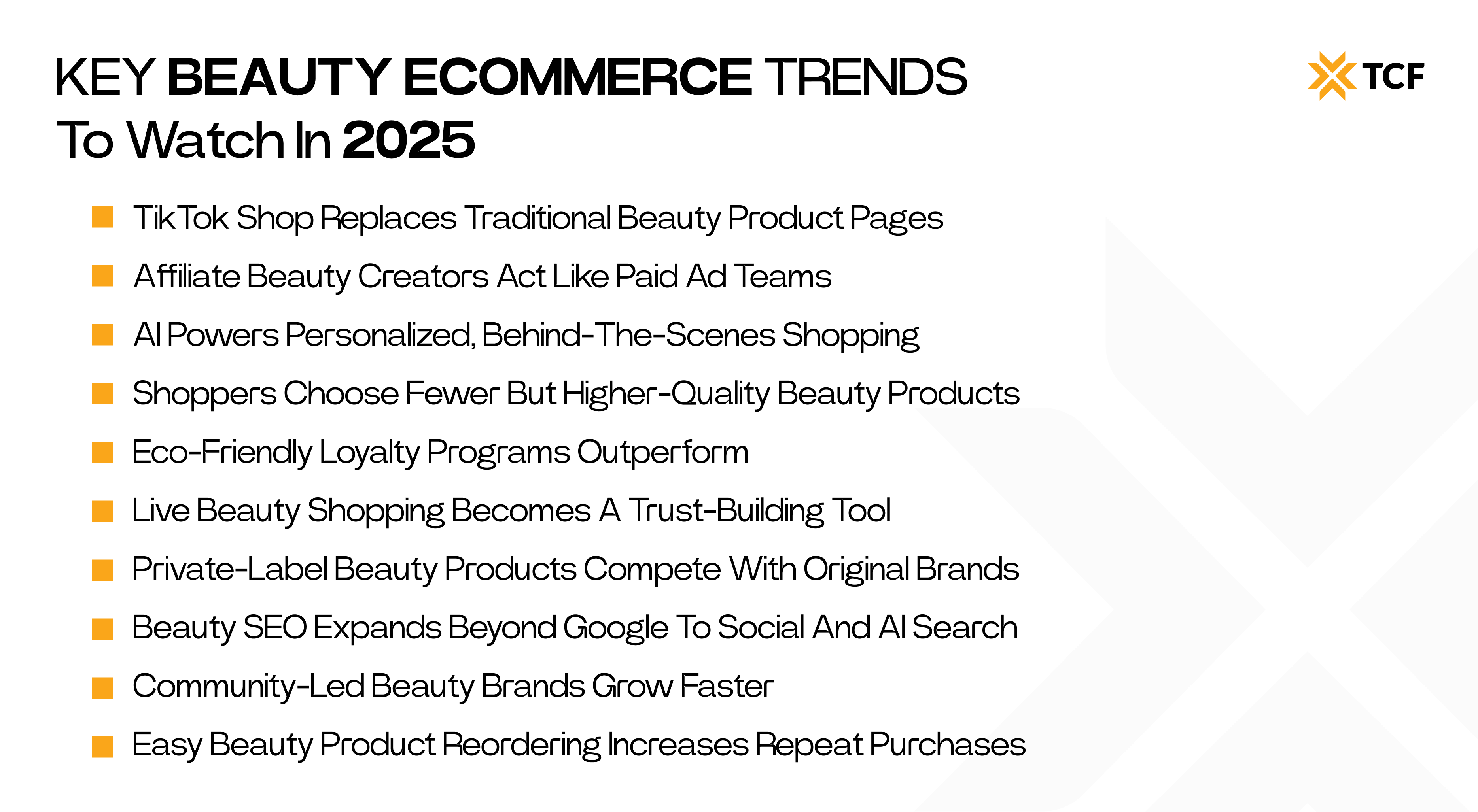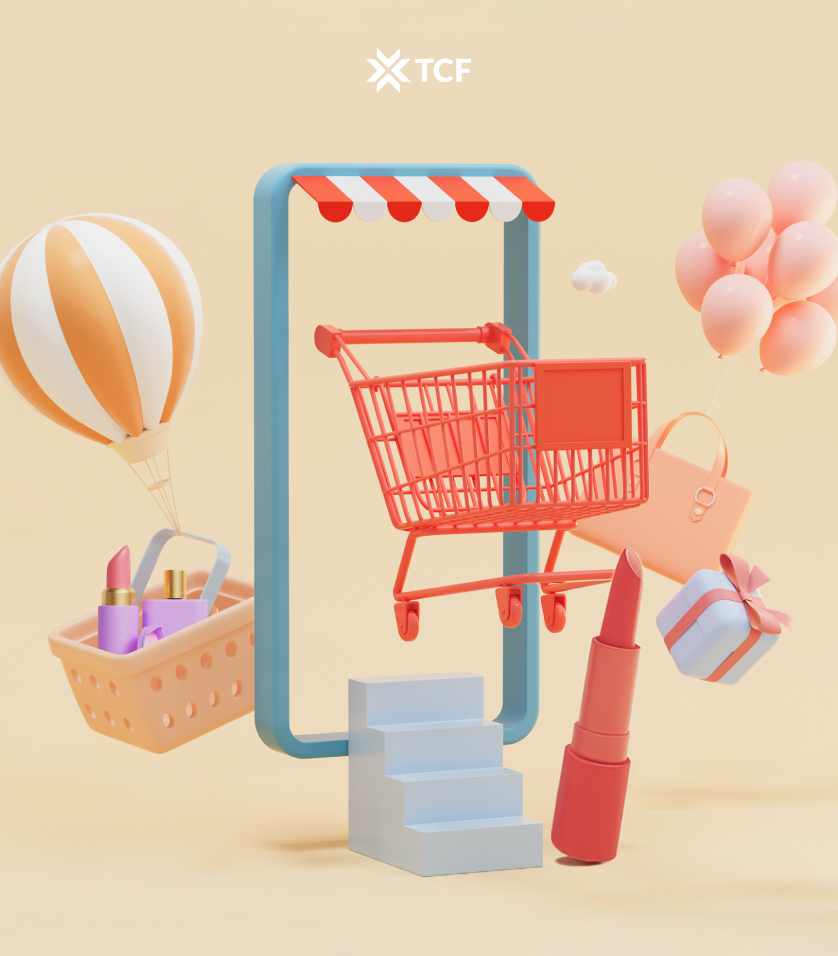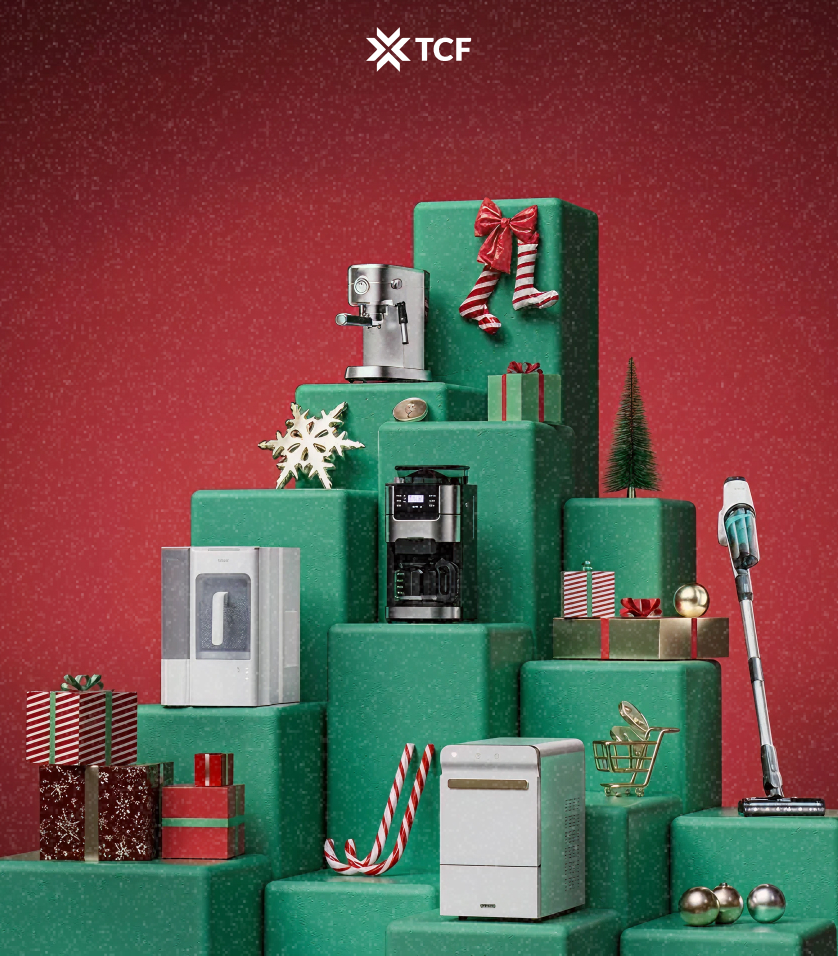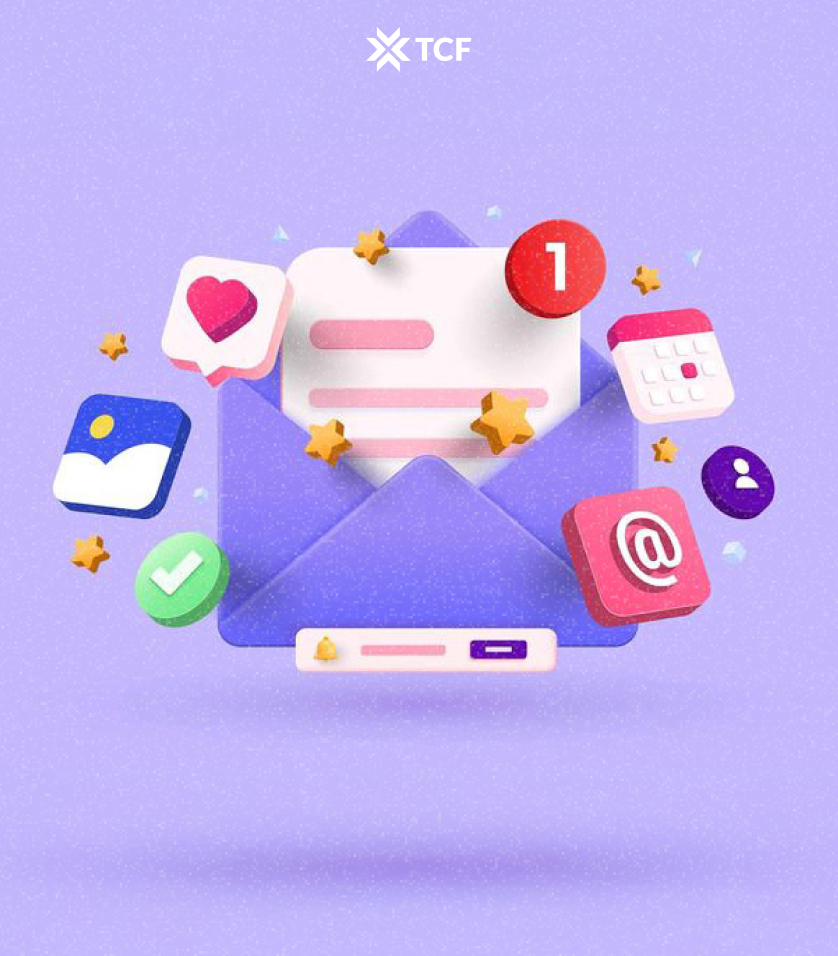Another year, another wave of beauty trend pieces telling you that “Gen Z likes authenticity” and that “clean beauty is still important.” Cool.
But if you’re running ecommerce at a beauty brand or building one from scratch you don’t need recycled headlines. You need to know what’s actually shifting in how consumers shop, how platforms behave, and how top brands are driving growth in 2025.
That’s what this article covers.
From TikTok Shop dominating the funnel to the rise of AI-powered replenishment flows and community-built SKUs, these are the trends shaping real decisions, campaigns, and roadmaps across beauty ecommerce. Not someday. Right now.
As a bonus, each trend below comes with strategy-level insight and practical takeaways.
Let’s get into it!
[[cta5]]
What Are the Main Beauty Ecommerce Trends of 2025?
If you’re running a beauty brand or working on one, you’ve probably seen a million trend lists already. Most of them say the same things every year. We tried to collect the shifts that are actually showing up in sales, content, and customer behavior and the ones smart brands are acting on right now.

1. TikTok Shop Is Replacing the Traditional Product Page
In 2025, shoppers do their browsing, learning, and buying directly inside TikTok. One short video often gives them everything they need: application tips, shade match, results, reviews, and a purchase button in the same scroll.
For beauty brands, TikTok Shop has become more than a sales channel. It acts as a full-funnel customer experience where content does the work of a product page. Instead of clicking through a site, customers watch a GRWM, check the comments for feedback, and check out in seconds.
Brands that treat TikTok like an ecommerce platform are seeing stronger performance from simple, unpolished, high-trust content. TikTok-exclusive SKUs, creator storefronts, and UGC-led reviews are now core parts of how beauty is sold.
How to use this trend:
- Pick a high-performing SKU and focus on showing how it fits into someone’s daily routine.
- Use video to answer the kinds of questions shoppers would normally ask on your site.
- Partner with creators who already talk to the right audience, and give them content prompts built around real use, not hype.
- If a video can do the job of a product page, lean into it.
2. Affiliate Creators Are the New Paid Media Arm
In 2025, more beauty brands are shifting away from flat-fee influencer campaigns and focusing on affiliate-based partnerships that perform like media buys. TikTok Shop and Shopify Collabs have made it easy to set up commission structures, track sales, and scale creator content without burning budget on one-time posts.
Affiliate creators are treating the products they feature like revenue streams, not short-term deals. This creates more frequent content, better product integration, and a stronger incentive to drive real conversions. The upside for brands is simple: lower risk, measurable results, and constant content without micromanaging briefs.
Some beauty brands now treat these creators like an extension of their ad team. They build offer stacks, rotate featured products, and test creatives based on click-through and sales, essentially running organic-first beauty ads without the usual overhead.
How to use this trend:
- Pick a few creators who already talk about similar products and invite them into an affiliate program with clear payouts and full creative freedom.
- Share high-performing assets they can use or remix, track performance weekly, and re-invest in the creators who bring in actual sales.
- Think of it like managing ad sets, except the content feels way more organic.
3. AI Gets Practical in the Background
AI is quietly becoming one of the most useful tools in beauty ecommerce. It’s being built into systems that help stores work faster, respond smarter, and reduce busywork without adding complexity.
Brands are using AI to send restock reminders based on actual usage patterns, personalize recommendations through quiz answers or uploaded selfies, and improve flows in email platforms like Klaviyo. It also plays a role in helping shoppers find the right shade, formula, or finish through visual inputs or browsing history.
Instead of being a standalone feature, AI now supports specific parts of the customer journey. It powers subtle but important upgrades like faster response times, smarter product matching, more relevant timing. This is helping teams create better shopping experiences without expanding headcount or building custom solutions from scratch.
How to use this trend:
- Use an AI-powered quiz to improve product recommendations.
- Set up smart restock flows in Klaviyo based on buying behavior.
- Add AI filters to reviews so shoppers can sort by skin type or concern.
- Test product page copy with tools like Jasper to boost conversions without rewriting everything manually.
- Start with one area and let the results guide your next move.
4. Low-Buy Beauty Behavior Is Reshaping How People Shop
More shoppers are following low-buy routines. They’re being more selective about what earns a place on their shelf. Product hauls are getting replaced by curated staples, and overstuffed routines are being swapped for simple, multi-use solutions.
Shoppers are looking for formulas that work harder, last longer, and feel worth the repurchase. Instead of impulse buys, they’re spending more time researching before they commit. They’re comparing ingredients, watching creator reviews, checking wear tests, and making room for fewer but better products.
This shift is rewarding brands that focus on long-term value. Refillable packaging, skin-first formulas, minimal routines, and visible results are playing a bigger role in buying decisions. And bundles that make sense without pressure are doing better than aggressive upsells.
How to use this trend:
- Highlight product longevity and real-world use.
- Bundle items that support simplified routines.
- Create content that shows how a single product can replace two or three others.
- Use reviews and creator content to build trust and show results over time.
- Focus on becoming someone’s go-to, not part of their clutter.
5. Green Loyalty Programs Are Actually Working
Eco-friendly perks are starting to outperform traditional point-based loyalty programs. Shoppers want rewards that align with their values, and brands are building programs around that. Instead of discounts or freebies, they’re offering things like refill credits, recycling bonuses, carbon offset points, or donations to environmental causes.
These programs are helping brands increase retention without racing to the bottom on price. They’re also making it easier to talk about sustainability in a concrete, customer-focused way. When rewards feel purposeful, shoppers are more likely to engage and more likely to stay loyal.
This shift doesn’t require a full loyalty overhaul. Even simple additions, like a refill-and-save incentive or points for using sustainable shipping options, can go a long way.
How to use this trend:
- Add a green action to your existing loyalty program.
- Offer points for sending back empty containers, choosing slower shipping, or buying refill packs.
- Share impact metrics so customers see the value.
- If your audience values sustainability, this is an easy way to keep them close without discounting.
6. Live Selling Moves Beyond Gimmicks
Live shopping is turning into a dependable way to connect with customers and move products. In beauty ecommerce, it works especially well when the format feels relaxed, consistent, and focused on showing how something performs in real time. Instead of making it feel like a pitch, brands are leaning into personal, helpful sessions.
Viewers want to see texture, shade comparisons, and real results. They appreciate being able to ask questions and hear answers on the spot. The more it feels like a chat with someone who knows what they’re doing, the more trust it builds.
Many brands are now hosting weekly sessions led by creators, makeup artists, or team members. Some focus on tutorials, others center around product education or quick tips. What they all have in common is a format that keeps people engaged and informed.
How to use this trend:
- Set a recurring schedule for your live sessions and keep the structure simple.
- Highlight one product or routine, show how it works, and answer questions from your audience.
- Share recordings on other channels to increase reach.
- The goal should be giving shoppers the info they need, in the format they prefer.
7. Private-Label Dupes Are Coming for the Originals
Retailers are launching their own versions of bestselling beauty products and they’re doing it with serious attention to detail. These go beyond basic alternatives. They’re well-formulated, trend-aware, and priced to appeal to shoppers who want results without the markup.
From Sephora to Target, more stores are building product lines that feel current, perform well, and mirror what’s trending on the beauty side of social media marketing. They’re releasing hydrating primers, lip oils, skin tints, and brow products that follow the same cues as viral favorites. And because they control the distribution, they’re able to own more of the buying journey.
This shift is changing how shoppers browse. Instead of brand-hopping, they’re finding go-to staples right where they already shop. And when those products perform, they’re likely to rebuy during the next haul.
How to use this trend:
- Stay ahead of the product curve.
- Watch what private-label lines are prioritizing and consider how your product range compares.
- If you’re an indie brand, highlight what makes your formulas different.
- If you’re a retailer, look for gaps in trending categories and test small-batch versions through your storefront or community.
8. SEO Now Starts Everywhere, Not Just Google
Search behavior in beauty is changing fast. Shoppers still use Google, but they also search on TikTok, Instagram, Pinterest, Reddit, and actively ask ChatGPT for product recommendations. That’s why SEO strategies in 2025 are becoming more visual, cross-platform, and creator-driven.
This shift is expanding what SEO means. SEO in 2025 is less about blue links and more about being visible. It’s about how your brand appears across social captions, creator content, visual search results, product tags, AI-generated lists, and chatbot answers. Traffic is still valuable, but impressions and visibility are becoming the real lead-ins to conversion.
When your product is easy to recognize, easy to explain, and frequently mentioned across channels, it becomes easier to find no matter where someone starts their search.
How to use this trend:
- Make Content Easy for AI to Extract: Organize product and brand info clearly using headings, bullet points, and concise answers.
- Cover All Related Questions: Google’s AI Overviews often expand and reframe queries before showing results. Match that pattern.
- Think Multimodal from the Start: Add visuals, video explainers, carousels, and even audio to help your content travel further.
- Use Schema Markup to Help AI Understand Your Content: Apply structured data like Product, FAQ, and Review schema to boost discoverability.
- Be the Primary Source: AI tools elevate original research, benchmarks, and firsthand insight. Add something new.
- Use consistent naming across listings, hashtags, and reviews: That consistency makes it easier for both humans and algorithms to connect the dots.
9. Community-Driven Brands Are Building in Public
Beauty brands are no longer growing behind closed doors. They’re building in the open, turning everyday interactions into loyalty touchpoints. From sharing product updates to showing team moments or answering questions directly in the comments, the most resonant brands are making their audience feel like part of something.
This goes beyond asking for opinions on product details. The focus is on being present, easy to talk to, and creating spaces where your audience can engage with you and with each other. Think of it less as “talking at your audience” and more as creating places for conversation, feedback, and shared experiences. That could be through a creator ambassador group, a loyal customer feature series, a Discord server, or even interactive live streams.
Shoppers now look for brands that feel alive, brands that listen, respond, and evolve alongside their audience.
How to use this trend:
- Start with one recurring format that opens a two-way conversation.
- Feature real customers in your content.
- Build a private space where your top fans can connect.
- Respond to comments and DMs like you're texting a friend.
- Community is retention. Show up like someone they’d want to hang out with again.
10. Reorders Are the New Growth Channel
Reorders have always been part of ecommerce, but in 2025, they’re getting treated like a full-fledged growth channel, right alongside acquisition. And subscriptions are only one piece of the puzzle.
Beauty brands are combining subscription models with smarter one-click reordering, refill reminders, and loyalty perks to keep customers coming back. The focus is shifting from locking shoppers into a subscription to giving them flexible, low-effort ways to repurchase. Because the real win isn’t the auto-ship, it’s the long-term relationship.
Retention teams are building entire flows around this. They’re using AI to predict when someone might run out, sending reminders timed to usage cycles, and making reorders feel seamless across email, SMS, and even push. The easier it is to rebuy, the more likely they will.
How to use this trend:
- Set up Klaviyo flows that trigger reorder reminders based on product usage timelines.
- Add “Buy Again” buttons to your customer account pages.
- Offer flexible subscription options like skip-a-month or one-time add-ons.
- Use QR codes on packaging that go straight to a refill product page.
- Reward second purchases with instant loyalty points or limited-time gifts.
Conclusion
Beauty ecommerce in 2025 is moving fast. The trends shaping it are already showing up in the way people search, shop, and connect with brands. From TikTok-led purchases to community-powered loyalty and smart reordering flows, the playbook is getting sharper, more practical, and more aligned with how real shoppers behave.
Now’s the time to build with intention. Choose the trends that fit your brand’s strengths, test small, and scale what works. Whether it’s affiliate creators, smarter retention, or AI-backed experiences, each shift opens up a new way to grow without relying on guesswork.
Focus on what brings value to your customers, and the growth will follow.
[[cta5]]






.png)


.png)




